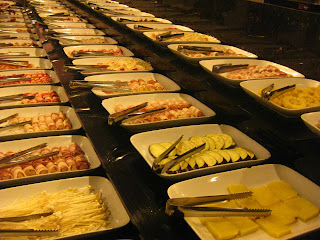I know this is long overdue. I actually made a draft a few days back and when I went back to it yesterday, it's gone! :(
If it's your first time here, please see the previous posts:
Chronicles of the sweet tooth problemHow to know if it's really PMS and
Ways to relieve PMSNow, if you're done with that, let's move on!
There are 20 more left in the list so I'm dividing them to two entries. Below are the first ten:
6. Eat more fiber
- It helps decrease excess estrogen (which is one of the most likely causes of PMS)
- It helps improve glucose intolerance (many women have trouble with fluctuating blood glucose levels during PMS phase)
- It reduces the the urge to binge
- It helps the body fully utilize progesterone
How to get it? Eat nuts, cereals, fruits and veggies!
7. Eat the good fats -- GLA and Omega 3
Gamma linoleic acid is involved in the metabolism of prostaglandins that regulate pain and inflammation in the body. Excellent sources are
evening primrose oil, black currant oil and borage seed oil while
Omega 3 helps decrease inflammation, stabilize blod sugar, fight acne (no to zits!)and increase production of endorphins. We can get this from fat or oil of cold water fish such as
anchovies, tuna and salmon.8. PhytoestrogensIn layman's term, plant estrogens. These are not chemically identical to the ones our body produce but it can function like it. This is good for those whose estrogen levels are too high or too low. How to get it? Eat a diet rich in plant foods and eat a couple of servings of soy-based foods each week.
9. Vitamins & 10. MineralsWe know that we all need vitamins and minerals and yes, we can just get those commercially available ones that says complete from A-Z. But what are the specific vitamins and minerals that will be most useful in treating PMS symptoms? See links
1,
2 and
3.
11. ExerciseI think I don't have to say much about this but just to emphasize, regular exercise is particularly helpful in relieving symptoms related to depression and tension, such as mood swing, fatigue, irritability and cramps.
12. Natural Progesterone Seventy-five percent of women affected by PMS appear to have too little progesterone so it actually makes sense to give a supplementary to fill the lack.
Water retention, breast tenderness and insomnia are just some of the symptoms that this hormone can help ease. While there are several forms of natural progesterone, many experts recommend the
topical cream because it's easily absorbed and it mimics the ovaries' natural release of the hormone. To know more about this click
here.13. HerbsThere were ten herbs mentioned in the book but there was just one that (I think) is easy to find : Chamomile. Primarily, chamomile tea is used for its relaxing qualities but it actually exerts a number of positive effects on the body because it has natural anti-inflammatory, anti-bacterial and anti-fungal ingredients. For PMS, it can be used for symptoms triggered by tension or stress.
14. Avoid XenoestrogensThese are man-made substances that are structurally similar to estrogen, so it has the ability to bring on excess of the hormone. We can get this from nail polish, nail polish remover, bleach, cleansers and detergents. I know we can't completely avoid exposure to these things but we certainly can achieve a certain amount of caution, right?
15. Reduce StressThe connection between Stress and PMS is just very simple, when one is really stressed, symptoms of PMS gets really worse. What to do? Exercise or try something that helps you slow down, calms your body and mind and relax. Now I'm thinking of a warm bath, foot spa, a book or movie marathon.
Please see next post for the rest...
____________________________________________
Reference: Taylor, N. 25 ways to relieve PMS (2002). Chicago : Contemporary Books
Photos above are not mine. If you find one of your photos here and you would like to have them taken down, please message me.
































